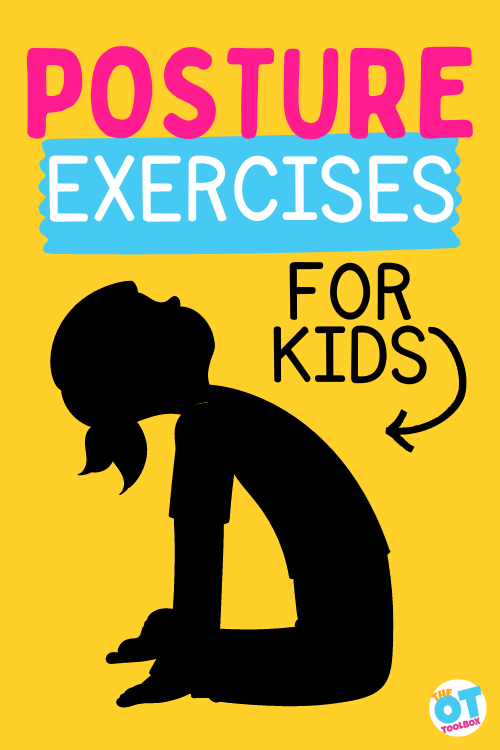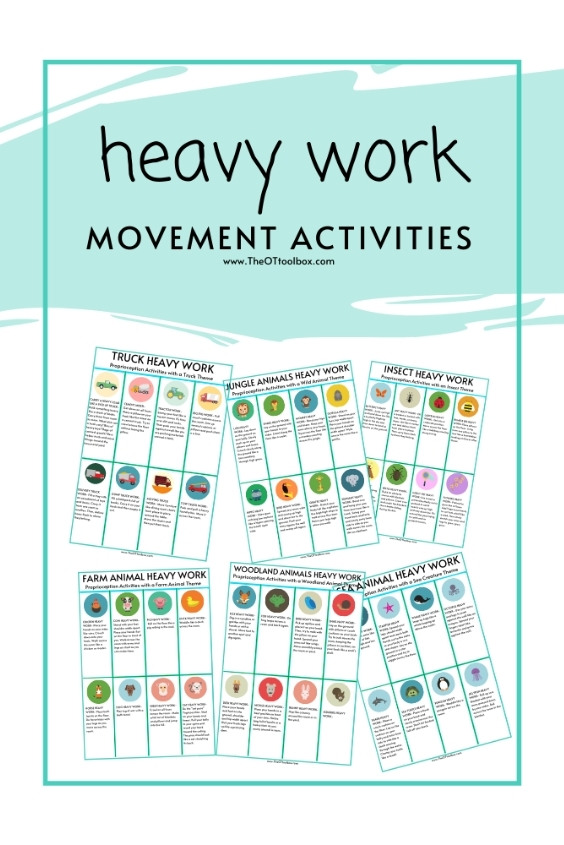In this article, we’ll cover posture exercises for kids, for several important reasons. Good posture for children is a fundamental aspect of gross motor coordination skills, physical health, and wellness, yet it is often overlooked in childhood. Developing good posture habits early on can have numerous benefits for children, including improved breathing, reduced strain on muscles and joints, and increased self-confidence. In this post, we’ll explore why good posture should be a priority for parents, as well as some fun exercises to try at home.

Posture Exercises for Kids
There’s more to posture than standing up straight. Beyond writing posture and supporting visual motor needs, there are many benefits to musculoskeletal alignment. There are also many underlying contributions to good posture to consider.
One of those aspects that is often overlooked is the relationship to primitive reflexes. Components of childhood development at a young age, including retained primitive reflexes such as the tonic labyrinthine reflex (TLR) can impact posture and result in a slouched position. When typical postural prompts, verbal and visual cues, and physical exercises don’t work, it can be helpful to look in greater detail at the possibility of a retained reflex.
Another consideration is core strength and stability. Tummy time, crawling, including various types of crawling at different stages, and the visual motor integration that develops at a young age impact posture later in development, as well.
Before we explore postural exercises in detail, let’s cover why postural support is necessary.
Then, we’ll cover kid-friendly posture exercises to support these areas.
Why do Kids need good posture?
Did you know that everyone, including children need to use good postural mechanics?
There are many reasons why it’s important to encourage children to maintain good posture from a young age.
Some of the key benefits of using good posture include:
Reduced strain on muscles and joints: Poor posture puts unnecessary strain on the muscles and joints, leading to discomfort and even injury over time. By developing good posture habits, children can reduce their risk of these issues in the present and future.
Visual motor implications: Upright positioning enables functional reach, alignment for upper body use in manipulating objects. The kinesiology implications in function are huge! When we look at the impact of copying skills in particular, posture impacts the visual motor skills needed for both near point copying as well as far point copying.
Better sports outcomes: If you child is a wannabe athlete, strengthening their stabilizing posture muscles first will allow them to develop their other muscles for their sport of choice.
Coordination- Motor planning is different depending on positioning. An upright posture to throw and catch a ball will have different results than a throw or catch made from a bent over or slouched posture. Similarly, the motor plan to form letters and numbers in written work can be altered by posturing at the desk. Similar differences in motor plans exist for all aspects of motor tasks.
Increased self-confidence: Good posture can also improve children’s self-confidence, as they feel more confident and in control of their body. Posture changes have been studied to show a boost in confidence overall.
Improved breathing: When you are hunched over, the lungs are not able to expand fully. Upright posture, especially with a neutral neck alignment, helps ensure that the lungs can expand fully, making it easier for children to breathe deeply and effectively.
There are several components involved with improved breathing as a result of posture:
- With improved breathing, we also get a plethora of benefits like reduced stress, better sleep, and more energy.
- Additionally, the relaxation breathing benefits supported by postural alignment are a self-regulation coping tool for all ages.
- As a result of musculoskeletal alignment, breath control is improved. This includes room for the lungs to expand to offer greater lung capacity.
Learning good posture early in life is a fool-proof way to have good posture later in life; the earlier we build a habit, the easier it will be to maintain long term!
Kid-Friendly Posture Exercises
There are many ways to work the posture muscles, but we only included the ones that we find work well to motivate children. After all, motivation is key!
Try these exercises along with your children – making it a family affair will increase overall well-being and model good habits for all.
Play: As occupational therapy professionals, we have to include play as the number one tool in supporting posture and good sitting posture in kids. Why? Because play is the number one occupation or role of children! It’s through play that children develop strength, coordination, motor planning, body awareness, visual motor skills, and more. All of these areas contribute to functional performance. Consider these strategies to use play as a tool to support good standing posture, good sitting posture, and postural alignment within movement tasks:
- Gross motor toys
- Tag games
- Sensory nature walk– walking on surfaces outdoors supports posture and body mechanics.
- Outdoor sensory diet tasks– Use these ideas to play outside in challenging and just right ways, all while supporting the development of posture in kids.
Wall Angel: This posture exercise for kids can be done as part of a therapy regimen, or added to a daily routine. Stand with your back against a wall, then raise and lower your arms, keeping them in line with your shoulders.
- Make it extra fun: pass a toy or a cup of water (outside water play, anyone?) in between your hands as you go.
Butterfly Wings: Stand or sit tall, then squeeze your shoulder blades together by moving your arms towards your back, then towards your front, like a butterfly flaps it’s wings. Sit still or fly around!
Animal Exercises: This one is a bigge. They all work on core and or shoulder strengthening, as well as some whole-body exercise! Here we have:
- Crab Walks
- Bear Crawls
- Inchworm on the floor
- Flamingo pose- Stand on one leg. Bend the other leg to touch the foot to the inside of the knee. Stand tall and maintain balance
- Giraffe Reach & Twist- Stand up tall with your arms stretched straight up overhead and your legs spread apart wide. Push your palms together, then bend over to the side to touch the ground. Then stretch back up to the middle overhead and bend to touch the ground on the other side. Bring your arms back up overhead. Walk around the room like a giraffe without bending your knees.
- Animal walk games– These can be modified to meet any need and level of skill ability.
Heavy Work Activities– The input of proprioceptive sensory system offered through heavy work activities offer organizing awareness of the body’s position in space through the joints and muscles. Activities can be used with any theme and offer support for making posture more of a conscious effort. Try these heavy work tools:
- Free Heavy Work cards– Print and play with these activities in therapy, home, or the classroom
- Simon Says Commands– Use these directives in a game-based version of movement activities.
- Jungle Heavy Work Activities
- Heavy Work Movement Cards– Print off 11 pages of movement activities
Core Strength Exercises– Core strength supports not only balance and coordination, but postural alignment and positioning in activities. Some ideas to try include:
- sit-ups
- planks
- push-ups
- wall-kicks
- pulling self on a scooter board
- donkey kicks
- crab walks
- yoga poses
- wheelbarrow walking
- therapy band exercises
Make Posture Exercises Fun for Kids
The key to encouraging children to develop good posture habits is to make the exercises fun and engaging. Here are a few ways to do this:
Play games: Incorporate posture exercises into games, such as having a contest to see who can hold a yoga pose the longest or who can crab walk the farthest without collapsing.
Use props: Use props, such as yoga mats, exercise balls, or even play equipment to make posture exercises more fun and interactive.
Make it a routine: Incorporate posture exercises into your daily routine, such as before bed or after breakfast.
Posture Exercises for Teens
For older children, teenagers, or even adults, it’s never too late to incorporate exercise into daily life. Teenagers and adults are likely to have increased time sitting throughout their day – at the desk at school, computer doing homework, or on the couch to watch TV.
You may have noticed in the older ages that that teens slouch in their seats while learning or writing at desks. Some of this may have to do with fatigue and sleep hygiene, but other aspect may be posture, and when this is the case, we can see the contribution to learning.
Usually the most natural way to work exercise into their daily lives is to join a sports team, yoga class, or similar to commit to a scheduled work out. Routine exercise plus some simple reminders at their desk to stretch periodically will be a great place to start.
All in all, good posture is an important aspect of physical health and wellness, and it’s never too early to start promoting these habits in children. By encouraging children to maintain good posture and making the exercises fun, parents can help ensure that their children grow up healthy and confident.

Sydney Thorson, OTR/L, is a new occupational therapist working in school-based therapy. Her
background is in Human Development and Family Studies, and she is passionate about
providing individualized and meaningful treatment for each child and their family. Sydney is also
a children’s author and illustrator and is always working on new and exciting projects.
SPECIAL SALE PRICE AT 50% OFF!
These cards are normally $6.00 Need to add heavy work to help kids regulate emotions, or to use as a coping tool for sensory needs? Heavy work is a valuable strategy to add calming proprioceptive input for whole body awareness, regulation, and stress relief too. Help kids re-group or add movement into learning with these themed brain break cards. 11 pages of themed heavy work activity cards, with 8 activities for each theme. Click here for this special price for readers of The OT Toolbox.







